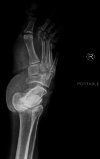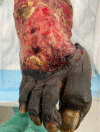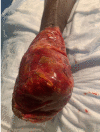Revascularization of a Crushed Foot and Ankle Mortis
- PMID: 33364088
- PMCID: PMC7749866
- DOI: 10.7759/cureus.11561
Revascularization of a Crushed Foot and Ankle Mortis
Abstract
Foot crush injury is a difficult problem both from the complexity of the injury pattern standpoint and also the significant clinical and socioeconomic burden that it represents to the patient. Scoring systems exist to predict limb salvage, but the accuracy and implementation of these are varied, and thus clinical judgment must always be employed when attempting limb salvage. This case report describes the first use of a reversed saphenous interposition graft repair of a transected dorsalis pedis in a patient after sustaining crush injuries to the distal lower extremity. The patient was able to undergo partial limb salvage with the use of revascularization and judicious fasciotomies.
Keywords: amputation; crush injury; extremity; extremity trauma; limb salvage; revascularization; trauma; vascular surgery.
Copyright © 2020, El Haddi et al.
Conflict of interest statement
The authors have declared that no competing interests exist.
Figures




Similar articles
-
Successful salvage of a crushed upper limb and reconstruction of brachial artery injury using a saphenous venous graft.J Vasc Surg Cases Innov Tech. 2025 Mar 17;11(3):101786. doi: 10.1016/j.jvscit.2025.101786. eCollection 2025 Jun. J Vasc Surg Cases Innov Tech. 2025. PMID: 40256201 Free PMC article.
-
Ankle and foot fasciotomy: an adjunctive technique to optimize limb salvage after revascularization for acute ischemia.J Vasc Surg. 1989 Apr;9(4):594-7. J Vasc Surg. 1989. PMID: 2709528
-
A decade of experience with dorsalis pedis artery bypass: analysis of outcome in more than 1000 cases.J Vasc Surg. 2003 Feb;37(2):307-15. doi: 10.1067/mva.2003.125. J Vasc Surg. 2003. PMID: 12563200
-
Dorsalis pedis, tarsal and plantar artery bypass.J Cardiovasc Surg (Torino). 2004 Jun;45(3):203-12. J Cardiovasc Surg (Torino). 2004. PMID: 15179332 Review.
-
[Distal popliteal bypass in the diabetic patient. Clinical case].Minerva Chir. 1996 Jul-Aug;51(7-8):589-95. Minerva Chir. 1996. PMID: 8975163 Review. Italian.
Cited by
-
Managing Complex Foot Crush Injuries: A Case Report.Cureus. 2024 Jan 19;16(1):e52572. doi: 10.7759/cureus.52572. eCollection 2024 Jan. Cureus. 2024. PMID: 38371133 Free PMC article.
References
-
- Predictors and timing of amputations in military lower extremity trauma with arterial injury. Kauvar DS, Thomas SB, Schechtman DW, Walters TJ. J Trauma Acute Care Surg. 2019;87:0–7. - PubMed
-
- Lower extremity assessment project (LEAP) - the best available evidence on limb-threatening lower extremity trauma. Higgins TF, Klatt JB, Beals TC. Orthop Clin North Am. 2010;41:233–239. - PubMed
-
- Tourniquet use is not associated with limb loss following military lower extremity arterial trauma. Kauvar DS, Miller D, Walters TJ. J Trauma Acute Care Surg. 2018;85:495–499. - PubMed
-
- Determinants of return to work following non-life-threatening acute orthopaedic trauma: a prospective cohort study. Clay FJ, Newstead SV, Watson WL, McClure RJ. J Rehabil Med. 2010;42:162–169. - PubMed
-
- Below-the-knee arterial injury: the type of vessel may be more important than the number of vessels injured. Scalea JR, Crawford R, Scurci S, et al. J Trauma Acute Care Surg. 2014;77:920–925. - PubMed
Publication types
LinkOut - more resources
Full Text Sources
